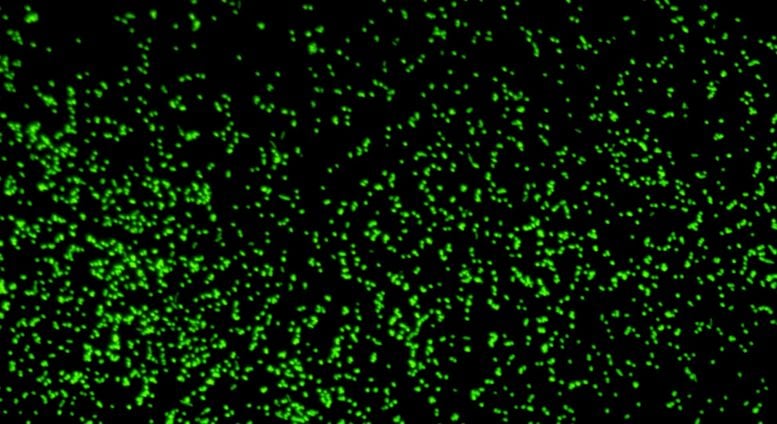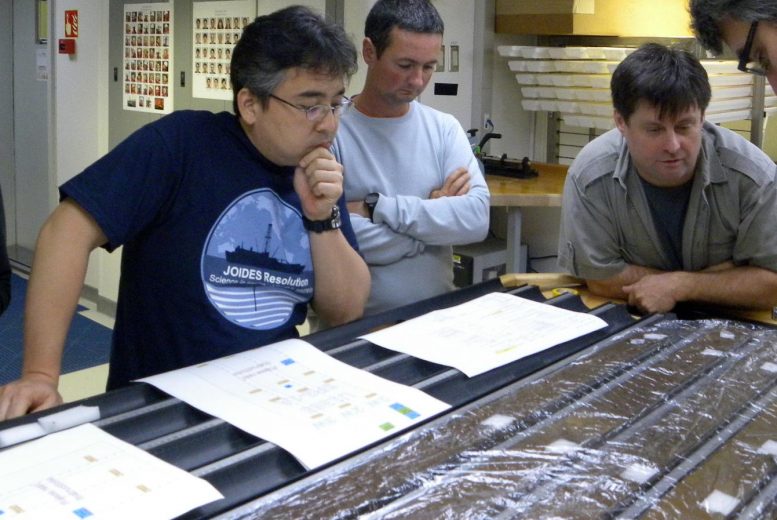
For decades, scientists have gathered ancient sediment samples from below the seafloor to better understand past climates, plate tectonics, and the deep marine ecosystem. In a new study published in Nature Communications, researchers reveal that given the right food in the right laboratory conditions, microbes collected from sediment as old as 100 million years can revive and multiply, even after laying dormant since large dinosaurs prowled the planet.
The research team behind the new study, from the Japan Agency for Marine-Earth Science and Technology (JAMSTEC), the URI Graduate School of Oceanography, the National Institute of Advanced Industrial Science and Technology, the Kochi University and Marine Works Japan, gathered the ancient sediment samples ten years ago during an expedition to the South Pacific Gyre, the part of the ocean with the lowest productivity and fewest nutrients available to fuel the marine food web.
“Our main question was whether life could exist in such a nutrient-limited environment or if this was a lifeless zone,” said the paper’s lead author Yuki Morono, senior scientist at JAMSTEC. “And we wanted to know how long the microbes could sustain their life in a near-absence of food.”
On the seafloor, there are layers of sediment consisting of marine snow (organic debris continually sourced from the sea surface), dust, and particles carried by the wind and ocean currents. Small life forms such as microbes become trapped in this sediment.

Aboard the research drillship JOIDES Resolution, the team drilled numerous sediment cores 100 meters below the seafloor and nearly 6,000 meters below the ocean’s surface. The scientists found that oxygen was present in all of the cores, suggesting that if sediment accumulates slowly on the seafloor at a rate of no more than a meter or two every million years, oxygen will penetrate all the way from the seafloor to the basement. Such conditions make it possible for aerobic microorganisms–those that require oxygen to live–to survive for geological time scales of millions of years.
With fine-tuned laboratory procedures, the scientists, led by Morono, incubated the samples to coax their microbes to grow. The results demonstrated that rather than being fossilized remains of life, the microbes in the sediment had survived, and were capable of growing and dividing.
“We knew that there was life in deep sediment near the continents where there’s a lot of buried organic matter,” said URI Graduate School of Oceanography professor and co-author of the study Steven D’Hondt. “But what we found was that life extends in the deep ocean from the seafloor all the way to the underlying rocky basement.”
Morono was initially taken aback by the results. “At first I was skeptical, but we found that up to 99.1% of the microbes in sediment deposited 101.5 million years ago were still alive and were ready to eat,” he said.
With the newly developed ability to grow, manipulate and characterize ancient microorganisms, the research team is looking forward to applying a similar approach to other questions about the geological past. According to Morono, life for microbes in the subseafloor is very slow compared to life above it, and so the evolutionary speed of these microbes will be slower. “We want to understand how or if these ancient microbes evolved,” he said. “This study shows that the subseafloor is an excellent location to explore the limits of life on Earth.”
Before looking ahead to future research, D’Hondt took time to reflect on Morono’s achievement. “What’s most exciting about this study is that it shows that there are no limits to life in the old sediment of the world’s ocean,” said D’Hondt. “In the oldest sediment we’ve drilled, with the least amount of food, there are still living organisms, and they can wake up, grow and multiply.”
Reference: “Aerobic microbial life persists in oxic marine sediment as old as 101.5 million years” by Yuki Morono, Motoo Ito, Tatsuhiko Hoshino, Takeshi Terada, Tomoyuki Hori, Minoru Ikehara, Steven D’Hondt and Fumio Inagaki, 28 July 2020, Nature Communications.
DOI: 10.1038/s41467-020-17330-1
This study was supported by the Japan Society for the Promotion of Science (JSPS), the Funding Program for Next Generation World-Leading Researchers, and the U.S. National Science Foundation. This study was conducted using core samples collected during Expedition 329, “South Pacific Gyre Subseafloor Life,” of the Integrated Ocean Drilling Program.
9 Comments
As if one pandemic isn’t enough.
Yes, lets revive an organism that has been extinct for millions of years, sounds like a great idea…
It went extinct for a reason, we should leave it that way
Your both idiots, this is an amazing find. It’s people like you who’ve prevented human kind from evolving further then they have. You’ve lucky society has deemed your small useless minds a benefit to its survival and granted you access to it’s achievements like computers at all.
Back at ya, Imbecile.
Natural selection has deemed us worthy of survival.
Capitalism, free Markets and personal liberty gave us access to many individual’s achievements.
Government sponsored science is usually for war and the enrichment of overpaid connected scientists.
Who granted these people the right to drill in the ocean and risk unleashing a potentially deadly germ?
Gree great, what could possibly go wrong? T rex flu
I have learned a lot of information from your sharing, thanks a lot. Please continue sharing such interesting information.
Send some to wuhan, they’ll know what to do with it.
In general this is an amazing find.
And these weren’t extinct. That’s literally the point of the article. They are alive, and have been all this time. They were just sequestered.
That said, yeah, maybe this wasn’t the best year for this. Long dormant microbes need to be handled with extreme caution as we have no ideas how they might interact with modern surface organisms
Kamikaze germs !!